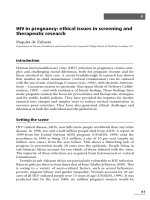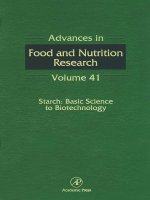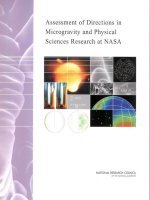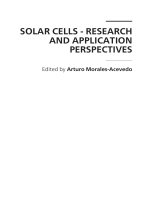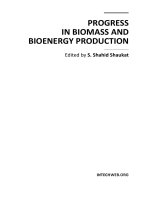adsorption progress in fundamental and application research
Bạn đang xem bản rút gọn của tài liệu. Xem và tải ngay bản đầy đủ của tài liệu tại đây (7.45 MB, 292 trang )
Adsorption
Progress in Fundamental and
Application Research
This page intentionally left blankThis page intentionally left blank
Adsorption
Progress in Fundamental and
Application Research
Selected Reports at the 4
th
Pacific Basin Conference
on Adsorption Science and Technology
Tianjin,
China 22 - 26 May 2006
editor
Li Zhou
Tianjin University, China
World
Scientific
NEW JERSEY • LONDON • SINGAPORE • BEIJING • SHANGHAI • HONG KONG • TAIPEI • CHENNAI
British Library Cataloguing-in-Publication Data
A catalogue record for this book is available from the British Library.
For photocopying of material in this volume, please pay a copying fee through the Copyright
Clearance Center, Inc., 222 Rosewood Drive, Danvers, MA 01923, USA. In this case permission to
photocopy is not required from the publisher.
ISBN-13 978-981-277-025-7
ISBN-10 981-277-025-9
All rights reserved. This book, or parts thereof, may not be reproduced in any form or by any means,
electronic or mechanical, including photocopying, recording or any information storage and retrieval
system now known or to be invented, without written permission from the Publisher.
Copyright © 2007 by World Scientific Publishing Co. Pte. Ltd.
Published by
World Scientific Publishing Co. Pte. Ltd.
5 Toh Tuck Link, Singapore 596224
USA office: 27 Warren Street, Suite 401-402, Hackensack, NJ 07601
UK office: 57 Shelton Street, Covent Garden, London WC2H 9HE
Printed in Singapore.
ADSORPTION
Progress in Fundamental and Application Research
Chelsea - Adsorption.pmd 11/26/2007, 11:00 AM1
v
FOREWORD
Adsorption-based technology has experienced a considerable change during the
past 30 years from a relatively minor technique to a major one that industry,
such as chemical or petrochemical, gaseous or liquid separation and/or
purification, relies on today following the progress achieved in the fundamental
research, development of novel adsorbents, new adsorption processes, and in
combination with other processes, which implies a great potential of decreasing
industrial cost. The present book, composed of selected papers of the 4
th
Pacific
Basin Conference on Adsorption Science and Technology held in Tianjin, China
for May 22-25, 2006, reflects partially the present state of the art.
Taking on the conference opportunity, about a hundred researchers got
together from 18 countries or districts to exchange the recent achievements in
adsorption research. However, a conference is indeed an information fair, whose
function is more informative than educative. In addition, some papers might not
be well organized/written due to the language problem. Therefore, instead of a
full proceeding, a collection of contributions is published in the monograph. It is
pitiful that some well known scholars could somehow not come to the
conference, yet quite a few authors of the monograph are well known for the
world adsorption community due to their publication and contribution to the
progress of adsorption in the past years. Therefore, what presented in this
monograph may attract the attention of adsorption researchers and do benefit
their job. It is also desired that some points of view put forward in the book will
consequence in more discussion or disputation, as such, real contribution is
made to the future development.
Li Zhou
Organizer of the 4-PBAST
Professor and director of
High Pressure Adsorption Laboratory
School of Chemical Engineering and Technology
Tianjin University, Tianjin, China
E-mail: ;
www.hpal-tju.com
This page intentionally left blankThis page intentionally left blank
vii
CONTENTS
Foreword v
Part A: General 1
Adsorption kinetics: theory, applications and recent progress 3
D. M. Ruthven
Pressure swing adsorption technology for hydrogen purification -
a status review 29
S. Sircar
New nanoporous adsorbents 46
A. Kondo, Y. Tao, H. Noguchi, S. Utsumi, L. Song, T. Ohba,
H. Tanaka, Y.Hattori, T. Itoh, H. Kanoh, C. M. Yang,
M. Yudasaka, S. Iijima, K. Kaneko
Experimental methods for single and multi-component gas
adsorption equilibria 57
J. U. Keller, N. Iossifova, W. Zimmermann, F. Dreisbach,
R. Staudt
Experimental determination of heat effects that accompany sorption
equilibrium processes 72
M. Bülow
Supercritical adsorption mechanism and its impact to application
studies 112
L. Zhou, Y. Sun, W. Su, Y. P. Zhou
Part B: Fundamental 127
Structural modeling of porous carbons using a hybrid reverse
Monte Carlo method 129
S. K. Jain, R. J M. Pellenq, K. E. Gubbins
viii
Controlling selectivity via molecular assembling in confined spaces:
alkanes-alkenes - aromatics in FAU zeolites 138
J. F. Denayer, I. Daems, G. V. Baron, Ph. Leflaive,
A. Methivier
A new methodology in the use of super-critical adsorption data to
determine the micropore size distribution 154
D. D. Do, H. D. Do, G. Birkett
Adsorption studies of cage-like and channel-like ordered mesoporous
organosilicas with vinyl and mercaptopropyl surface groups 175
M. Jaroniec, R. M. Grudzien
Adsorption studies of SBA-15 mesoporous silica with ureidopropyl
surface groups 189
B. E. Grabicka, D. J. Knobloch, R. M. Grudzien, M. Jaroniec
Effect of porosity and functionality of activated carbon in adsorption 199
F. Rodríguez-Reinoso
Phase behavior of simple fluids confined in coordination nanospace 206
M. Miyahara, T. Kaneko
Equilibrium theory-based design of SMBs for a generalized
Langmuir isotherm 213
M. Mazzotti
Non-equilibrium dynamic adsorption and desorption isotherms of
CO
2
on a K-promoted HTlc 221
S. P. Reynolds, A. D. Ebner, J. A. Ritter
Optimisation of adsorptive storage: thermodynamic analysis and
simulation 228
S. K. Bhatia, A. L. Myers
Part C: Application 237
Desulfurization of fuels by selective adsorption for ultra-clean fuels 239
Y S. Bae, J M. Kwon, C H. Lee
ix
Large scale CO separation by VPSA using CuCl/zeolite adsorbent 245
Y. C. Xie, J. Zhang, Y. Geng, W. Tang, X. Z. Tong
The ZLC method for diffusion measurements 253
S. Brandani
Chiral separation of propranolol hydrochloride by SMB process
integrated with crystallization 263
X. Wang, Y. Liu, C. B. Ching
This page intentionally left blankThis page intentionally left blank
Part A: General
This page intentionally left blankThis page intentionally left blank
3
ADSORPTION KINETICS: THEORY, APPLICATIONS AND
RECENT PROGRESS
DOUGLAS M. RUTHVEN
Department of Chemical and Biological Engineering University of Maine,
Orono, ME, 04469, USA
Over the past thirty years adsorption separation technology has developed from a
relatively minor niche process to a major unit operation, with adsorption processes in
widespread use in the petroleum and petrochemical industries and in the production of
industrial gases as well as in more traditional applications such as air and water
purification. The impact of improved understanding of the interplay between
adsorption, micropore diffusion and reaction on the development of zeolite catalyzed
processes has been even more dramatic. These developments have been stimulated by a
dramatic increase in adsorption research which has led to major discoveries ranging from
new microporous adsorbent materials to new theoretical approaches yielding improved
understanding of adsorption and diffusion in porous solids. Since a comprehensive
review is not possible in a single lecture this review has been restricted to a limited
number of areas in which recent research has led to the development of new processes or
to new concepts where future commercialization appears probable.
1. Zeolite Membranes
The possibility of producing thin coherent defect free zeolite membranes that
will allow industrially important molecular sieving separations to be carried out
as a continuous flow process has attracted much attention over the past decade
Table 1. Zeolite Membrane Separations
System Membrane
Material
Selectivity Flux
(kg/m
2
hr)
Ref
H
2
O/Ethanol NaA >10
3
5 - 15 Morigami et al [3]
Kondo et al [4]
Ethanol/H
2
O Silicalite 25 10 Motuzas [5]
CO
2
/CH
4
SAPO-34
DDR
50
200
2.5
1.3
Li
[6,7]
Tomita [8]
CO
2
/N
2
SAPO-34 16 0.6 Poshusta [9]
C
6
H
6
/C
6
H
12
NaX/NaY 100 0.1 Jeong [10]
Px/Mx Oriented MFI 200 0.05 Lai [11]
Hedlund et al [12]
4
[1,2]. Some examples are listed in Table 1. The separation of water from
alcohols (and other organics) by pervaporation through a Zeolite A membrane is
now commercial and the CO
2
/CH
4
separation, which is important for the
exploitation of many low grade natural gas wells, appears poised for
commercialization.
Permeance and Selectivity
The simplest model for permeation through a zeolite membrane assumes a linear
equilibrium isotherm and a constant diffusivity. The driving force is provided by
the difference in partial pressure across the membrane so:
( )
LH
pp
KD
N −=
ℓ
(1)
The constant of proportionality between the flux and the pressure difference
(KD/ℓ) is commonly referred to as the permeance while the product of the
permeance and the membrane thickness (KD) is referred to as the permeability.
At low sorbate concentrations (in the linear region of the isotherm) all
components of a mixture diffuse independently so the selectivity is given by:
BB
AA
B
A
AB
DK
DK
J
J
S ==
(2)
Since the temperature dependences of D and K follow respectively Arrhenius
and vant Hoff expressions [D = D
∞
e
-E/RT
; K = K
∞
e
-∆U/RT
] the permeance is
expected to vary exponentially with reciprocal temperature, either increasing or
decreasing depending on the relative magnitudes of E and ∆U. Such behavior
is commonly observed at low loadings (see figure 1a) [13]. However at higher
loadings the permeance generally passes through a maximum as shown in figure
1b [14].
To understand this behavior it is necessary to recall that the true driving
force for diffusive transport is the gradient of chemical potential, rather than the
concentration gradient. Assuming an ideal Langmuir isotherm with an ideal
vapor phase the flux is given by:
+
+
=
L
H
s0
bp1
bp1
n
qD
N ℓ
ℓ
(3)
in place of Eq. 21, where D
0
is the thermodynamically corrected transport
diffusivity defined by [15]:
5
∗
=≡
npd
nqd
DBRTD
0
ℓ
ℓ
(4)
Eq. 3 correctly predicts that, for given values of the upstream and downstream
partial pressures (p
H
and p
L
) the flux [and therefore the permeance defined as
J/(p
H
-p
L
)] will pass through a maximum with temperature, as commonly
observed. Note that at low loadings (bp << 1.0) Eq. 3 reduces to Eq. 1.
(a)
(b)
Figure 1. Temperature dependence of (a) Permeance and (b) Flux for permeation of permanent
gases and light hydrocarbons through silicalite membranes.
(a) shows permeance data for N
2
, CO
2
and nC
4
/iC
4
as a function of reciprocal temperature from data
of Kusabe et al [13]. Note that the data for permeation of nC
4
/ iC
4
mixtures (filled symbols)
show a reduced flux but a higher selectivity suggesting that the permeance of iC
4
is reduced more
than that of nC
4
by competitive adsorption.
(b) shows fluxes of CH
4
, C
2
H
6
, C
3
H
8
and n/iC
4
plotted as a function of temperature for fixed P
H
and
P
L
taken from data of Bakker et al [14].
Permselective Separations
In nanoporous materials diffusion is sterically hindered so that the diffusional
activation energy (and hence the permeance) are strongly dependent on
molecular size (see Fig. 2), thus giving rise to the possibility of size selective
molecular sieve separations. In extreme cases where one of the components is
sterically excluded from the pore system a highly efficient molecular sieve
separation may be achieved (provided that the membrane is coherent). However,
6
large separation factors are achieved only when the larger molecule is
completely excluded. If the larger molecule is small enough to enter the pores,
albeit slowly, the perm-selectively drops dramatically since in that situation the
conditions for single file diffusion are approached in which all molecules travel
at the rate of the slowest. This is illustrated in Table 2 [2].
Figure 2. Variation of permeance with kinetic molecular diameter for light gases in DDR type
zeolites at 301 K (o) and 373K (●). From Tomita et al. [8]
Table 2. Separation pattern of an AlPO
4
-5-in-nickel-membrane foil at 91
o
C and 1 bar pressure
difference over the membrane. Feed: binary mixtures 1:1 of n-heptane and an aromatic compound.
(From Caro et al [2]).
n-heptane
(single
component)
n-heptane/
toluene
n-heptane/
mesitylen
n-heptane/
triethylbenzene
n-heptane/
triisopropylbenzene
Flux x
10
6
/mole s
-
cm
2
3.9 0.85 0.43 1.82 0.94
Flux relative to
pure n-heptane
100% 22% 11% 47% 24%
Selectivity - 0.8 1.7 105 1220
Interference effects become important only at relatively high loadings so,
when there is a large difference in diffusivity between components, both flux and
selectivity decrease strongly with loading, as illustrated in Figure 3 [16].
7
Figure 3. Variation of flux and selectivity with loading for permeation of nC
4
/ iC
4
through a
silicate membrane. From Tsapatsis et al [16].
The perm-selectivity for a mixture is generally found to be lower than the
ratio of the pure component permeances (Eq. 2). However, this is not always
true. If the faster diffusing species is also the more strongly adsorbed species
then, under conditions of competitive adsorption, the adsorption of the slower
(and weaker) component will be suppressed by competitive adsorption leading to
an increase in perm-selectivity [17]. Such an effect has been observed for
n-hexane/dimethyl butane in a silicalite membrane for which separation factors
in the mixture are greater than 1,000 in favor of n-hexane [17, 18]. This effect
is particularly strong for mixtures containing a fast diffusing but weakly
adsorbed species (such as H
2
) and a more strongly adsorbed but slower diffusing
species (e.g. H
2
/SF
6
or CH
4
/C
4
H
10
) [19, 20].
At high sorbate loadings the effect of differences in adsorption equilibrium
tends to become dominant. Thus for methane/n-butane on a silicalite membrane
the pure component diffusivity ratio, at ambient temperature, is about three in
favor of methane. However, in the binary mixture the selectivity is inverted
leading to preferential permeation of n-butane (S
CH4/nC4
≈ 0.06) [21]. The
transient behavior of this system is shown in Figure 4. When a clean silicalite
membrane is exposed to a 50-50 binary mixture of methane + n-butane the
permeate is initially almost pure methane. The butane penetrates the membrane
more slowly so that butane appears in the permeate only after about 45 secs. As
the butane flux increases the methane flux declines because the strongly
adsorbed butane hinders access of the methane to the pores. If the temperature
is increased above 200
o
C the butane loading decreases to a sufficiently low level
that methane again becomes the preferentially permeating species.
8
Figure 4. Transient permeation behavior of a 50-50 binary mixture of CH4/nC4H10 in a silicalite
membrane at 298K. From Geus et al [21].
Modeling of Permeation in Binary Systems
To properly account for such effects a more sophisticated model is necessary.
The most promising approach, developed by Krishna and his associates, is based
on the generalized Maxwell-Stefan (GMS) model [22-30]. The basic
expression for the flux in a multicomponent system is:
oi
i
n
is
ijs
jiij
i
i
D
N
Dq
NqNq
RT
q
+
−
=µ∇−
∑
=
(5)
where D
oi
represents the thermodynamically corrected transport diffusivity for
component i (defined in accordance with Eq. 7) and Ð
ij
represents the mutual
diffusion co-efficient. For a binary Langmuirian system Eq. 8 reduces to:
( )
[ ]
ABOABABOBA
B
ABOBAA
A
ABOBAB
BA
OAs
A
D/DD/D1
dz
d
D/D
dz
d
D/D1
.
1
Dq
N
θ+θ+
θ
θ+θ+
θ
θ+θ−
θ−θ−
−
=
(6)
with a similar expression for N
B
. When interference between the diffusing
species is negligible (Ð
AB
→ ∞) this reduces to the simplified expression
originally derived by Newton, Round and Habgood [31].
The corrected diffusivities (D
OA
, D
OB
) can be derived from single
component measurements but the mutual diffusivity (Ð
AB
) is not amenable to
direct measurement. Krishna has suggested using the Vignes correlation [32] as
an estimation method:
9
BA
B
BA
A
OBOAAB
D.DD
θ+θ
θ
θ+θ
θ
=
(7)
or, for molecules of different sizes the modified form [27]:
( )
( )
BA
B
BA
A
OB
OA
sOASBABS
DqDqDq
θ+θ
θ
θ+θ
θ
=
(8)
where q
SA
and q
SB
represent the saturation capacities for the two components.
This development is based on the ideal Langmuir model for adsorption
equilibrium. However the theory can be adapted to incorporate any
thermodynamically consistent model for the equilibrium isotherm. The
development based on the more realistic ideal adsorbed solution theory (IAS)
has been presented by Kapteijn et al [27].
Representative comparisons between the experimental permeance and
selectivity (for CH
4
/C
2
H
6
-silicalite) and the predictions of the GMS model based
on single component data are shown in Figure 5 [26]. Also shown are the
corresponding predictions from the Habgood model in which mutual diffusion
effects are ignored. For the slower diffusing species (C
2
H
6
) the predicted flux is
only marginally altered by mutual diffusion but for the faster diffusing species
(CH
4
) the effect of mutual diffusion is considerable so that selectivity predictions
based on the simplified Habgood model are substantially in error.
Figure 5. Separation of C
2
H
6
/CH
4
mixtures by permeation through a silicalite membrane (a) Flux;
(b) Selectivity.
10
Continuous lines show the predictions of the Maxwell-Stefan model (Eq. 9) based on single
component values of D
0
with Ð
AB
estimated from Eq. 11 Dotted lines show predictions of the
Habgood model in which mutual diffusion is ignored (Ð
AB
→ ∞). From van de Graaf et al [26].
A similar situation is observed for the separation of CO
2
/CH
4
on a SAPO-34
membrane [6,7] (i.e. mutual diffusion leads to higher separation)factors than
those predicted from the simplified Habgood model.
A detailed analysis of the influence of mutual diffusion has been carried out
by Karimi and Farooq [33]. They show that the effect is generally small at low
loadings but becomes important at high loadings when the difference in the
mobilities of the two components is large.
Commercialization
Despite their exciting potential the commercialization of zeolite membranes has,
so far, been limited. The main barrier appears to be the difficulty of producing
sufficiently robust and durable membrane modules of the size required for
commercial operation.
Figure 6. Permeance and selectivity for CO
2
/ (50/50 mixture) in a SAPO-34 membrane as a
function of temperature. Note: the mixture selectivity is greater than the “ideal” selectivity
predicted from single component permeances [6].
11
2. Kinetic Separations
There are a number of cyclic adsorption separation processes in which the
selectivity depends on differences in adsorption rate rather than on differences in
equilibrium. Three representative examples of such processes are given below.
Olefin/Paraffin Separations
The separation of light olefins (C
2
H
4
and C
3
H
6
) from the corresponding
paraffins (C
2
H
6
and C
3
H
8
) has traditionally been carried out by cryogenic
distillation [34]. However the difference in boiling points is small so the
process is energy intensive and therefore costly. The possibility of developing a
more competitive adsorption separation process has therefore attracted much
research. The earliest such processes took advantage of the fact that, on
cationic zeolites, olefins are adsorbed more strongly than the corresponding
paraffins [36]. However, the equilibrium selectivity is relatively modest (K
A
/K
B
~ 10) and not sufficiently high to achieve a high purity olefin product at high
recovery. The possibility of developing an efficient kinetic separation has
therefore attracted much recent attention [36-38].
Figure 7 shows diffusivity data for the C
2
and C
3
olefins and paraffins in
several different 8-ring zeolites. In 5A zeolite diffusion of the C
2
species is not
significantly constrained by steric hindrance so the diffusional activation energy
is low (~ 1.5 kcal/mole) with little difference in diffusivity between C
2
H
4
and
C
2
H
6
. Steric hindrance is substantially greater in 4A zeolite resulting in higher
diffusional activation energies and significantly faster diffusion of C
2
H
4
, which is
the slightly smaller molecule. However, in zeolites of the CHA family, the
pores of which are controlled by distorted 8-rings, the differences in diffusivity
between olefins and paraffins are much greater (3 to 4 orders of magnitude for
C
3
H
6
/C
3
H
8
on high Si CHA). Comparative uptake curves for this system are
shown in Figure 8.
The window dimensions and hence the diffusivity and the diffusivity ratio
are correlated with the unit cell size. Si CHA, which has the smallest cell size,
has the highest kinetic selectivity but the diffusion of propylene is rather slow,
thus restricting the cycle time. The choice between a high selectivity with slow
uptake of propylene and a lower selectivity with faster uptake thus represents an
interesting optimization problem.
12
Air Separation on Carbon Molecular Sieves
Carbon molecular sieves (CMS) adsorbents are produced by pyrolysis of
carbonaceous materials followed by carefully controlled deposition of carbon
within the pores [43]. In contrast to activated carbons which have a broad
distribution of micropore size (generally in the 10 – 100 Å range) the pores of a
carbon molecular sieve are very small (< 10 Å) and the pore size distribution in
narrow. As a result the adsorption behavior is similar to that of a zeolite.
Carbon molecular sieves are widely used for production of nitrogen from air
(by selective adsorption of oxygen). There is little difference between the
equilibrium isotherms of O
2
and N
2
on CMS but as a result of its slightly smaller
molecular size oxygen is adsorbed very much faster (diffusivity ratio 10 – 100).
The sorption kinetics show some interesting features.
Diffusion in Zeolite A
1.00E-12
1.00E-11
1.00E-10
1.00E-09
1.00E-08
1.00E-07
1.00E-06
2.6 2.7 2.8 2.9 3 3.1 3.2 3.3 3.4
1000/T
Do (cm
2
/sec)
C2H6 -5A
C3H8 - 5A
C2H4 - 4A
C2H6 - 4A
(a)
13
Diffusion in CHA Zeolites
1.00E-15
1.00E-14
1.00E-13
1.00E-12
1.00E-11
1.00E-10
1.00E-09
1.00E-08
2.3 2.5 2.7 2.9 3.1 3.3
1000/T
Do (cm
2
/sec)
C3H6 - SAPO 34
C3H6 - ALPO 34
C3H6 - SiCHA
C3H8 - ALPO 34
C3H8 - Si CHA
(b)
Figure 7. Arrhenius plot showing the temperature dependence of intracrystalline diffusivity for C
2
and C
3
hydrocarbons in 8-ring zeolites (a) 4A and 5A, (b) CHA zeolites. Data are from refs 36-38
(CHA) and 39-42 (A).
Figure 8. Comparative (integral) uptake curves for C
3
H
6
and C
3
H
8
in SiCHA at 80º C, 600 Torr.
From Olson et al [37]. Note that the curves show linearity in
t
in the initial region as expected
for diffusion control.
14
(a) (b)
Figure 9. Variation of (a) surface mass transfer coefficient and (b) internal diffusivity with loading
for O
2
and N
2
in BF CMS at 298K. From Sundaram et al[46].
Detailed studies show that the sorption kinetics are controlled by a
combination of surface resistance and internal diffusion although, depending on
the particular adsorbent and the conditions, one or other of these resistances may
be dominant [44-47]. The uptake curves show a clear transition from surface
barrier control in the initial region to diffusion control at long times. The
differential diffusivity and the surface mass transfer coefficient both increase
strongly with loading; much more strongly than is predicted by the
thermodynamic correction factor (Eq. 4). The data are correlated by the
empirical expressions:
θ−
θ
β+=
θ−
θ
β+=
1
1
k
k
;
1
1
D
D
1
00
(9)
where for N
2
β = β
1
= 1.8 and for O
2
β = 0.76, β
1
= 0.89. Note that for β = 0
these expressions reduce to the Darken correction for a Langmuir isotherm since
dℓnq/dℓnp = 1-θ (see Eq. 4). The physical explanation of this behavior has not
yet been established.
N
2
/CH
4
Separation over ETS-4
Titanosilicalites such as ETS-4 represent a new class of crystalline microporous
molecular sieves, similar to zeolites in their general structure but significantly
different in their composition. Like the small pore zeolites ETS-4 has a three
dimensional channel structure controlled by 8-membered oxygen rings but the
dimensions of the unit cell and hence both the size and shape of the 8-ring
windows change dramatically with the dehydration temperature [48]. Provided
